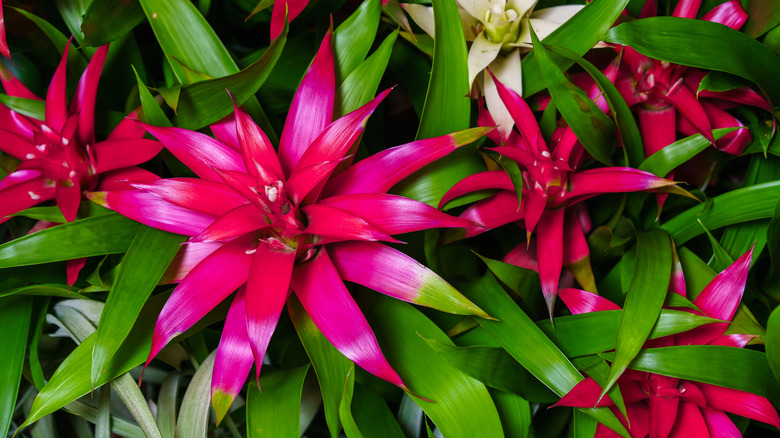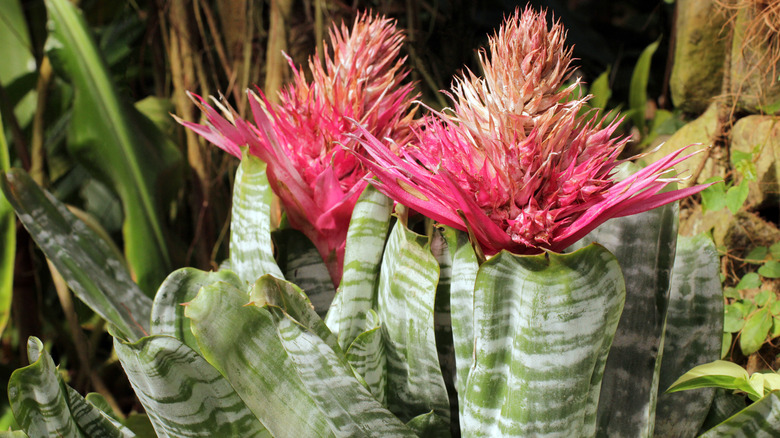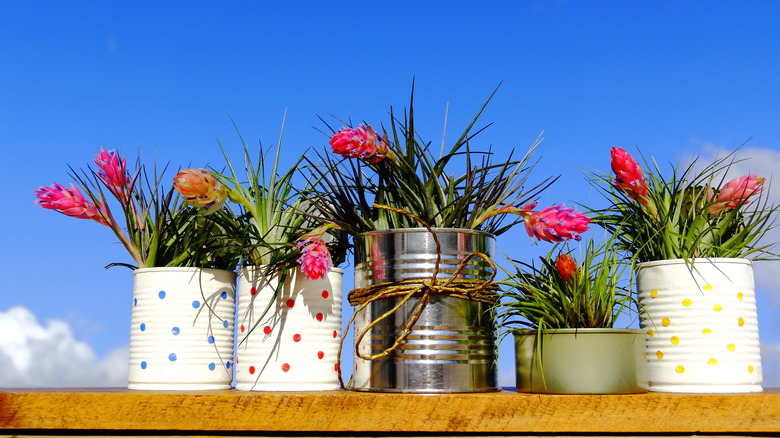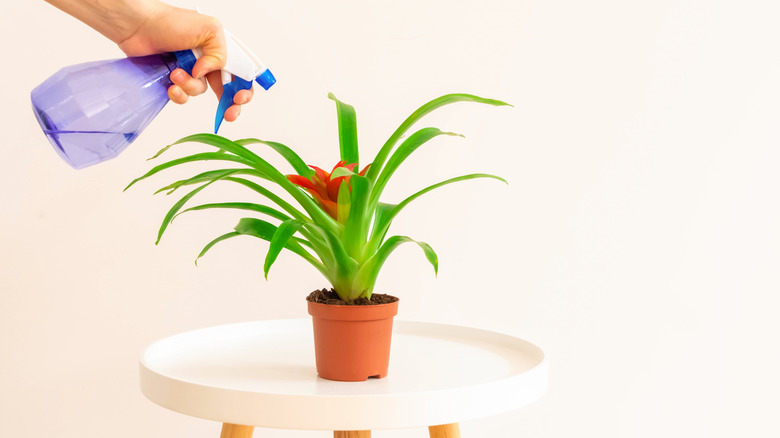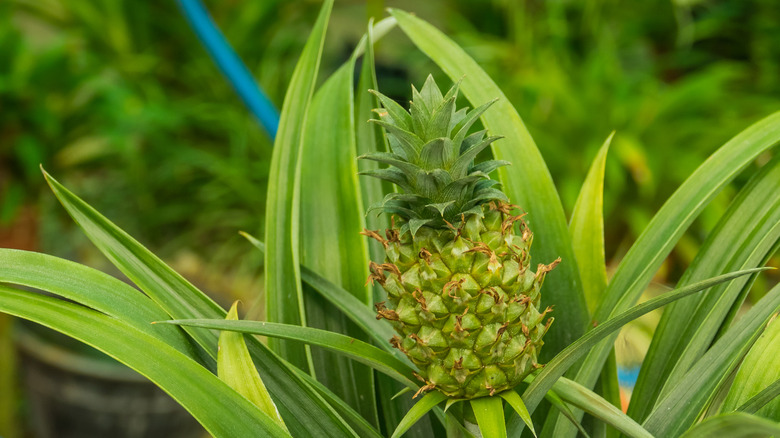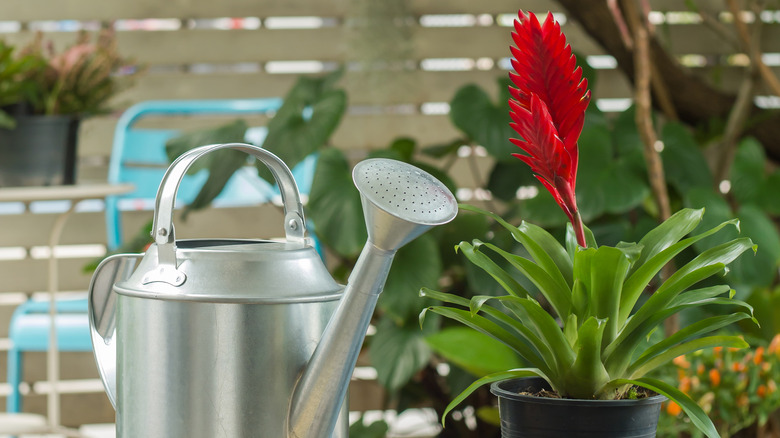How To Correctly Grow And Care For Bromeliad
The bromeliad or bromeliaceae is a vibrant and fun plant that can be cultivated both indoors and outdoors. Its bright and colorful leaves are often mistaken for flowers, but are actually called bracts and are a constant feature of the plant — no need to wait for it to flower to get the effect (via Bromeliads.info). Bromeliads are native to the tropical and subtropical Americas, according to The Spruce, and come in a variety of colors, including red, pink, orange, and purple. they also come in a wide variety of species.
Odds are, you've likely encountered bromeliads before. More than that, you've probably eaten one. Pineapples are a member of the bromeliaceae genus, and the only edible fruit produced by a bromeliad variety.
Not only is this plant beautiful — and delicious — but it is not as hard to cultivate as it may seem. While there are many types of bromeliad, there are also plenty of easy-to-grow varieties to liven up your indoor spaces or backyard. Bromeliads are also completely non-toxic to humans and pets, according to the ASPCA.
How to use bromeliad in garden
Bromeliads are native to tropical environments, and as such tend to thrive best in warmer, humid environments. SFGate states that most bromeliads are best suited year round in zones 10 and 11 (Hawaii, Southern California, Southern Florida, etc.), although there are species that do well in cooler climates all year. It is common to grow bromeliads in containers so you can easily transfer them inside and outside, depending on the season. If you live somewhere that frosts, it is a good idea to move your bromeliad indoors before the first frost hits (via Bromeliads.info).
Most bromeliads will become scorched in the full direct sun, but there are some varieties, such as dyckia, protea, and hectia, that will tolerate the direct sun. This is especially helpful if you would like to use bromeliads as ground cover or decoratively in landscaping.
According to The Spruce, bromeliads can be grown either terrestrially, in soil, or epiphytically, clinging to trees. Their variety, adaptability, and beauty make them an excellent outdoor plant option — as long as you get the right variety for your climate.
How to grow bromeliad
Bromeliads can be grown from seeds, and can also be propagated from their offshoots, called pups. To obtain a bromeliad seed, you can either purchase one, or look for a seed pod on your plant. According to Bromeliads.info, it is quite rare that your bromeliad will self-pollinate, and if they do produce seeds, they only keep for four weeks to three months.
Once you obtain your seeds, you'll need to germinate them. To do this, poke holes in a clear food container or plastic bottle for drainage and fill it with a soilless potting mix, preferably a slightly acidic one. Wet your soil and put your dried seeds on top — do not mix or cover your seeds with dirt. Cover with a clear lid or plastic wrap to let light through while maintaining moisture. Keep in indirect light, ideally around 70 to 80 degrees, and once two or three leaves have sprouted, you're ready to repot it.
To propagate a pup, simply remove it from the mother bromeliad when it's 1/3 to 1/2 the size of the mother plant by cutting it with a sharp knife (per Bromeliads.info). Then repot in an appropriate potting mix.
How to care for bromeliad
Caring for bromeliads varies by variety. According to The Spruce, there are a few generalizations to keep in mind when approaching bromeliad care. Bromeliads with bendable and softer, spineless leaves need less light, and more rigid, hard-leafed varieties will require more light. The outlet also states that yellowed plants may be getting excess light, while dark green bromeliads likely aren't getting enough.
Bromeliads will generally prefer moist soil. Water a little bit a few times a week, and cut back on this during dormant months. Bromeliads are prone to root rot, so do not let them sit in standing water or let their soil get soggy. Some bromeliads are less acclimated to dry air than others, and may require misting.
It is not necessary to fertilize most bromeliads, per SFGate, but if you would like to, dilute the fertilizer to 1/4 of its usual potency. And while these generalizations are a good guide, make sure you are caring for your bromeliad variety's specific needs.
Varieties of bromeliad
According to Bromelia, there are around 2,800 varieties of bromeliads and 75 genera, all with different physical attributes and care needs. While they are all native to tropical environments, there are a stunning variety of the unique species. If you're looking for inspiration on which variety to take home, here are just a few of those varieties, per The Spruce.
-
Guzmania Bromeliads — This variety of bromeliad comes in a ton of bright colors, and is often kept as a houseplant.
-
Vriesea Bromeliads — These bromeliads are suited to low light conditions, and produce small blossoms and feathery bracts.
-
Billbergia Bromeliad — Outdoors, these bromeliads are epiphytic, but are also common indoor potted plants.
-
Cryptanthus Bromeliads — Also known as earth stars, this variety is unique for having a unique visual appeal, sporting dark leaves, pink and red accents, banding, and/or spots.
-
Ananas comosus — The only bromeliad to bear edible fruit comes from the pineapple bromeliad.
How to repot bromeliad
When repotting a bromeliad, one of the most important choices you'll need to make is what kind of pot to choose. Apartment Therapy warns that, since bromeliads are impacted to moisture, you need to choose a pot that will be appropriate not only to the plant, but also your climate. If you live in a dryer climate, it is a good idea to replant your bromeliad in a plastic pot that will retain the moisture. If you live in a more moist climate, though, a porous pot would be better, such as terracotta or clay.
Bromeliads are best kept in smaller pots due to their small root systems, as noted by Nola.com. A fully grown bromeliad may not need to go larger than a 6 inch pot. Repotting should be done in the spring. When putting your bromeliad in its new pot, be careful not to plant it too shallow or too deep, but to the base of the leaves. If your bromeliad cannot stand by itself, add some stakes to help support it, and remove them when its root system has grown large enough to support the plant. Use a barky, airy soil mix for your bromeliad, suggests Espoma.
